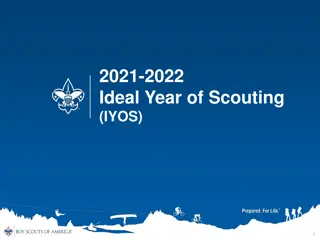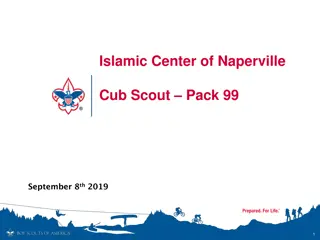Scouting Heritage Merit Badge Requirements
Explore the history and significance of Scouting through the requirements of the Scouting Heritage Merit Badge. Learn about Lord Baden-Powell, key figures in early American Scouting, program evolution, and options to experience Scouting history firsthand. Delve into the origins and development of Scouting in this educational journey.
Download Presentation

Please find below an Image/Link to download the presentation.
The content on the website is provided AS IS for your information and personal use only. It may not be sold, licensed, or shared on other websites without obtaining consent from the author.If you encounter any issues during the download, it is possible that the publisher has removed the file from their server.
You are allowed to download the files provided on this website for personal or commercial use, subject to the condition that they are used lawfully. All files are the property of their respective owners.
The content on the website is provided AS IS for your information and personal use only. It may not be sold, licensed, or shared on other websites without obtaining consent from the author.
E N D
Presentation Transcript
Scouting Heritage Merit Badge If you don t plan it, it won t happen!
Just the FACTS Status: Created: Discontinued: BSA Advancement ID: Requirements revision: Latest pamphlet revision: Elective 2010 no 143 2018 2014 If you don t plan it, it won t happen!
Requirements 1. Discuss with your counselor the life and times of Lord Baden-Powell of Gilwell. Explain why he felt a program like Scouting would be good for the young men of his day. Include in your discussion how Scouting was introduced in the United States, and the origins of Boy Scouting and Cub Scouting under Baden-Powell. If you don t plan it, it won t happen!
Requirements 2. Do the following: a. Give a short biographical sketch of any TWO of the following, and tell of their roles in how Scouting developed and grew in the United States prior to 1940. Daniel Carter Beard William D. Boyce Waite Phillips Ernest Thompson Seton James E. West b. Discuss the significance to Scouting of any TWO of the following: Brownsea Island The First World Scout Jamboree Boy Scout Handbook Boys Life magazine If you don t plan it, it won t happen!
Requirements Requirements 3. Discuss with your counselor how Scouting s programs have developed over time and been adapted to fit different age groups and interests (Cub Scouting, Boy Scouting, Exploring, Venruring). If you don t plan it, it won t happen!
Requirements Requirements 4. Do ONE of the following: a. Attend either a BSA national jamboree, OR world Scout jamboree, OR a national BSA high-adventure base. While there, keep a journal documenting your day-to-day experiences. Upon your return, report to your counselor what you did, saw, and learned. You may include photos, brochures, and other documents in your report. b. Write or visit the National Scouting Museum. Obtain information about this facility. Give a short report on what you think the role of this museum is in the Scouting program. c. Visit an exhibit of Scouting memorabilia or a local museum with a Scouting history gallery, or (with your parent's permission and counselor's approval) visit with someone in your council who is recognized as a dedicated Scouting historian or memorabilia collector. Learn what you can about the history of Boy Scouting. Give a short report to your counselor on what you saw and learned. If you don t plan it, it won t happen!
Requirements 5. Learn about the history of your unit or Scouting in your area. Interview at least two people (one from the past and one from the present) associated with your troop. These individuals could be adult unit leaders, Scouts, troop committee members, or representatives of your troop s chartered organization. Find out when your unit was originally chartered. Create a report of your findings on the history of your troop, and present it to your patrol or troop or at a court of honor, and then add it to the troop s library. This presentation could be in the form of an oral/written report, an exhibit, a scrapbook, or a computer presentation such as a slide show. If you don t plan it, it won t happen!
Requirements 6. Make a collection of some of your personal patches and other Scouting memorabilia. With their permission, you may include items borrowed from family members or friends who have been in Scouting in the past, or you may include photographs of these items. Show this collection to your counselor, and share what you have learned about items in the collection. (There is no requirement regarding how large or small this collection must be.) If you don t plan it, it won t happen!
Requirements 7. Reproduce the equipment for an old-time Scouting game such as those played at Brownsea Island. You may find one on your own (with your counselor s approval), or pick one from the Scouting Heritage merit badge pamphlet. Teach and play the game with other Scouts. In the afternoon we would have a game, such as 'deer- stalking', in which one boy went off as the 'deer', with half a dozen tennis balls in his bag. Twenty minutes later four 'hunters' went off after him, following his tracks, each armed with a tennis ball. The deer, after going a mile or two, would hide and endeavour to ambush his hunters, and so get them within range; each hunter struck with his tennis ball was counted gored to death; if, on the other hand, the deer was hit by three of their balls he was killed. Kim's Game, Hunt the Whale, Deerstalking, Follow the Trail, Knot-Tying Race, Bear Hunt, Tug-of-War. If you don t plan it, it won t happen!
Requirements 8. Interview at least three people (different from those you interviewed for requirement 5) over the age of 40 who were Scouts. Find out about their Scouting experiences. Ask about the impact that Scouting has had on their lives. Share what you learned with your counselor. If you don t plan it, it won t happen!
Questions? Questions? If you don t plan it, it won t happen!
Questions? Questions? If you don t plan it, it won t happen!
Questions? Questions? If you don t plan it, it won t happen!























